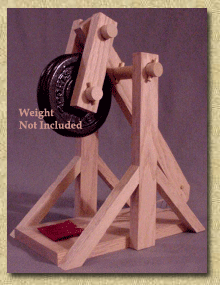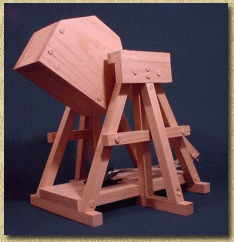|
|
Sling Weapons - Sling ,Staff Sling ,Catapult
and Trebuchet
The Evolution of Sling Weapons from the Simple Sling to the Trebuchet.
| Sling
Probably the earliest projectile throwing device used by man, the simple
sling acted as an extension of the thrower's arm resulting in a mechanical
advantage that increased projectile range and speed.
The sling consists of two cords and a flexible pouch. With a projectile
placed in the folded pouch, the loose ends of both cords are held in one
hand.
When ready, the thrower draws back his arm and swings the sling up and
forward. Just before apex, the thrower releases one cord, opening
the pouch and sending the projectile on a ballistic path.
In trained hands, the sling was very accurate. Although best known for
its role in the story of David and Goliath, slings were used by most, if
not all, ancient armies. The Egyptian, Greek and Roman armies used slings
in combat. |
 |
 |
Staff Sling
The staff sling was a logical advancement over the sling. Using a single
pole, or staff, in place of two cords, the staff sling allowed for heavier
projectiles and an increased rate of fire.
One end of the staff sling’s pouch is fixed to the staff, while the
other end is free. The free end has a hole, or loop, slipped over a pin
extending from the end of the staff, or notch cut into the staff.
The pin is bent, or the notch cut, so as to allow the free end of the pouch
to slip off at the proper angle releasing the projectile.
Invention of the staff sling was instrumental in the development of
ancient torsion catapults and eventually,
trebuchets. |
| Torsion Catapult
The torsion catapult , or onager as it is also known, is the combination
of a simple sling and a large staff sling, or arm, powered
by a bundle of twisted cord , or skein.
The onager allowed the Romans to employ fairly large projectiles at
relatively long range. It fired not only solid projectiles, but also a
form of grapeshot made from smaller stones baked in a clay ball. |
 |
 |
Trebuchet
Introduced in the twelfth century, the trebuchet was a major advancement
in warfare. Like the onager , the trebuchet employed the advantages of
both the simple sling and staff sling , but used the energy of a falling
weight to throw massive projectiles great distances.
The trebuchet was used primarily as a siege weapon for attacking fortifications.
Because of their enormous size, trebuchets were built at the siege site,
using local materials, if available. |
|
Save up to 50% with Multi-Plan Deals
|
| 2 Plans $19.95 FREE Shipping
- Save Over 30%
U.S. Orders Only |
|
| Do It Yourself Working Model Trebuchet Kit |

|
 Trebuchet
Kit
Trebuchet
Kit
Item
#TK
|
$75.00
Free
Shipping
U.S. Orders Only |

|
The trebuchet kit includes fully precut and drilled
frame parts, pins and axles, sling cord and sewn pouch, projectiles and
fully illustrated assembly and firing instructions.
Unlike the flimsy, snap together plywood trebuchet
kits, this all hardwood trebuchet kit does not require additional cutting,
trimming or shaping.
This DIY Trebuchet Kit requires only white carpenter's
glue and a few bar clamps (not included) to assemble.
Read
More > |
| Fully Assembled Working Model Trebuchet |

|

daVinci Trebuchet
Item # T4
|
$299.00
Free
Shipping
U.S. Orders Only
|

|
Inspired by the great war machines and siege catapults of Leonardo da Vinci
, this all Red Oak
hardwood trebuchet features
an open counterweight cabinet for range and trajectory adjustment.
Fire with an empty counterweight for indoor use, or add weight (nuts,
bolts, scrap lead, iron or steel, sand, or small rocks not included)
for increased range.
Individually crafted from cabinet-grade red oak, the da Vinci Trebuchet
stands 14 inches tall in the cocked position, 24 inches tall in the fired
position and will hurl a projectile up to 60 feet. Includes six projectiles
and fully illustrated instructions.
Read More > |
The Evolution of Sling Weapons from the Simple Sling to
the Trebuchet. |